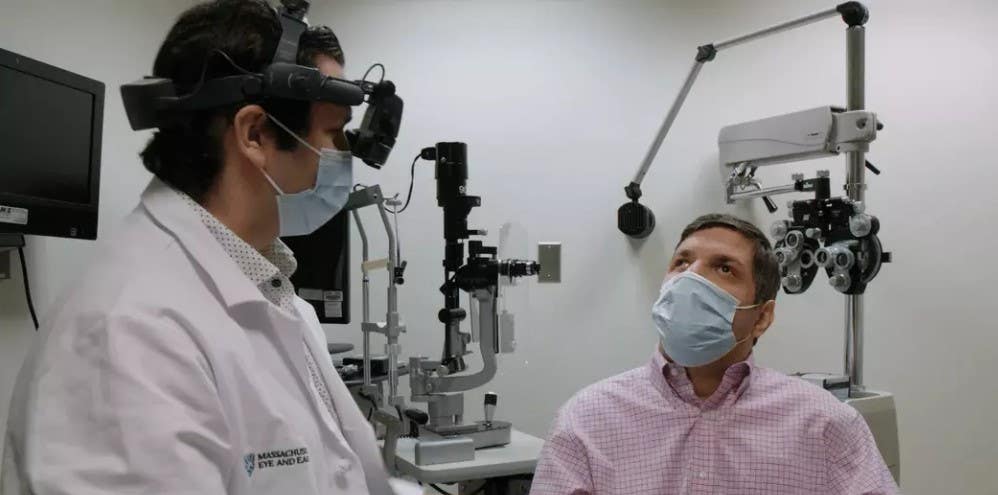This technology can improve the eyesight of the visually impaired. Here’s how
Gene-editing technology was tested on seven volunteers to see if it could treat severe visual impairment and enabling them to see colours.

[Nov 17, 2021: Mark McCord]
A man gets a check-up to continue the effort to improve his visual impairment. (CREDIT: Mass Eye and Ear)
More evidence for the efficacy of a groundbreaking new gene-editing medical procedure has emerged, deepening hope it will provide one-shot treatments or even cures for cancer, sickle cell anaemia and other conditions.
Some people suffering from a rare severe visual disorder were able to see more clearly after being treated using the gene-editing technology known as CRISPR, according to reports.
For the first time, CRISPR gene-editing tools were injected directly into the human body, in this case to tackle the leber congenital amaurosis (LCA) condition that made it difficult for the volunteers to navigate their surroundings or see colours.
What is CRISPR?
In 2012, CRISPR, which stands for Clustered Regularly Interspaced Short Palindromic Repeats, was first engineered as a biological tool capable of precisely altering DNA. Over the last decade, scientists around the world have continued to improve the safety and efficacy of CRISPR technologies, opening the door to potentially treating a range of genetic diseases.
For years, scientists have been trying to devise treatments that directly address the root cause of disease on the genetic level. Many commonly-used drugs act like a sledgehammer and non-specifically treat disease, which can lead to negative side effects and have varying impact across patients.
CRISPR falls into a category called precision medicine, which can precisely address the specific genetic defect causing a particular disease.
Related Stories
CRISPR works by combining scissor-like proteins with other molecules to locate troublesome parts of a person’s DNA blueprint – the genome.
CRISPR allows scientists to remove these disease-causing regions of the genome or replace them with DNA that stops or reverses the illness.
CRISPR is already used for a range of applications, from simple diagnostic tools to basic research purposes. During the pandemic, scientists created a CRISPR-based test for COVID-19.
But its wider rollout as a therapy depends on more trials and examination of possible side effects. Over a year following the CRISPR-based treatment of a patient with sickle cell disease, positive health improvements suggest that gene editing may offer a viable cure for many genetic diseases, but broad testing and long-term monitoring remain vital.
A new development in gene-editing treatment
The application to LCA volunteers at Oregon Health & Science University’s Casey Eye Institute in the US is a first of its kind.
To date, CRISPR treatments involved taking cells from a patient and changing parts of the subject’s DNA before reinserting the edited cells back into the patient. Once back inside the body, the cells could multiply and hopefully eliminate the disease.
In the Oregon trials, however, the CRISPR tools were injected directly into the seven volunteers without removing any of their cells. In their case, it was inserted into the retina of the eye.
This new technique holds out hope for treatment of conditions in parts of the body from which cells can’t be safely removed, such as the brain.
“It’s a really amazing technology and very powerful,” Dr Mark Pennesi, Professor of Ophthalmology at the Institute told NPR.
CRISPR improved the sight of some patients
One of the Oregon volunteers, Carlene Knight, said she was able to safely navigate her surroundings following the procedure, while another, Michael Kalberer, found he could see colours for the first time.
At his cousin’s wedding, Kalberer discovered that he “could see the DJ’s strobe lights change colour and identify them to my cousins who were dancing with me,” he told NPR. “That was a very, very fun, joyous moment.”
The trial is still ongoing and other volunteers didn’t experience the same improvement. So it’s too soon to say when CRISPR will be able to treat sufferers of other genetic illnesses as effectively.
Like these kind of feel good stories? Get the Brighter Side of News' newsletter.
Tags: #New_Innovations, #Medical_News, #Vision, #Eyes, #Research, #CRISPR, #Science, #The_Brighter_Side_of_News
Joseph Shavit
Head Science News Writer | Communicating Innovation & Discovery
Based in Los Angeles, Joseph Shavit is an accomplished science journalist, head science news writer and co-founder at The Brighter Side of News, where he translates cutting-edge discoveries into compelling stories for a broad audience. With a strong background spanning science, business, product management, media leadership, and entrepreneurship, Joseph brings a unique perspective to science communication. His expertise allows him to uncover the intersection of technological advancements and market potential, shedding light on how groundbreaking research evolves into transformative products and industries.



